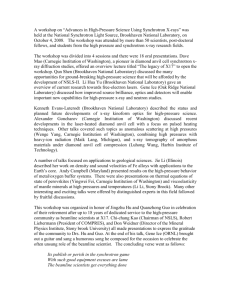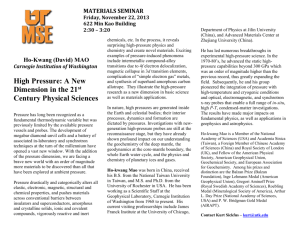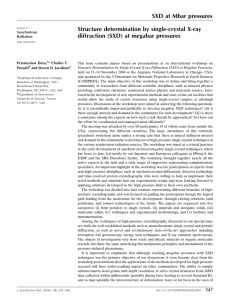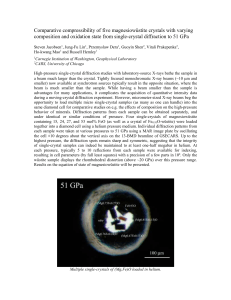Determination of the high - pressure phases (II ’
advertisement
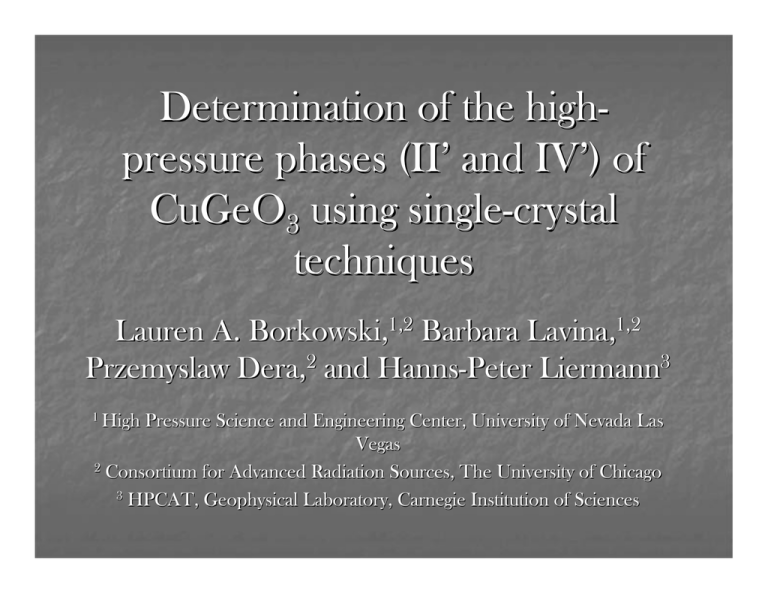
Determination of the highpressure phases (II’ and IV’) of CuGeO3 using single-crystal techniques Lauren A. Borkowski,1,2 Barbara Lavina,1,2 Przemyslaw Dera,2 and Hanns-Peter Liermann3 1 High Pressure Science and Engineering Center, University of Nevada Las Vegas 2 Consortium for Advanced Radiation Sources, The University of Chicago 3 HPCAT, Geophysical Laboratory, Carnegie Institution of Sciences Reasons to Study CuGeO3 First known inorganic material to exhibit a spinPeierls transition Phase transitions are dependant on the hydrostaticity of the pressure medium Majority of previous pressure studies were conducted using Raman spectroscopy and powder x-ray diffraction The structures of the high pressure phases have not been determined December 7, 2007 International Workshop on Synchrotron High-Pressure Mineral Physics and Materials Science Phase Transitions ~ 7 GPa Phase II hydrostatic orthorhombic ~ 14 GPa Phase II’ ~ 22 GPa monoclinic Phase VI tetragonal Phase I monoclinic quasi-hydrostatic orthorhombic ~ 7 GPa monoclinic Phase III December 7, 2007 ~ 8 GPa Phase IV monoclinic ~ 12 GPa Phase IV’ International Workshop on Synchrotron High-Pressure Mineral Physics and Materials Science orthorhombic ~ 18 GPa Phase V Experimental Details Energy Dispersive X-ray Diffraction Data collected at 16BMB White Beam Single crystal diffraction Ge solid state detector Monochromatic X-ray Diffraction Data collected at 13BMD 45 keV beam Single crystal diffraction Image plate detector December 7, 2007 International Workshop on Synchrotron High-Pressure Mineral Physics and Materials Science Single Crystal Energy Dispersive Xray Diffraction Determine the d-spacings of the reflections by their energy Determine the orientation matrix from the position of the reflections in reciprocal space Use of polychromatic beam Allows more reflections to have the Bragg’s conditions satisfied in the available geometry than monochromatic radiation Use of a Ge solid-state detector as a point detector Better determination of the intensity of the individual reflections than area detectors December 7, 2007 International Workshop on Synchrotron High-Pressure Mineral Physics and Materials Science EDX4DAC Typical experiment Center the sample in the chi circle Manually offline then determine how the sample moves during a full 360° χ rotation Peak search Determine orientation matrix Center peaks that constrain the orientation matrix Centered in relationship the ω and χ angles Typically 20 – 30 peaks Calculate a data collection list usually at one energy Collect intensity data December 7, 2007 International Workshop on Synchrotron High-Pressure Mineral Physics and Materials Science Peak Search The sample is scanned for reflections At each 1° χ step the sample rotates through the ω range in 1° steps as well To get a good sampling of the reciprocal lattice the peak search should be allowed to reach at least χ = 90° December 7, 2007 International Workshop on Synchrotron High-Pressure Mineral Physics and Materials Science Indexing the Crystal −The reciprocal space is filtered, and “cleaned” −Difference vectors are calculated −UB matrixes are derived −The “cleaned” reflection list becomes the centering list −The reflections are centered in both ω and χ to get the precise location of the peaks −The centered list further constrains the UB matrix December 7, 2007 International Workshop on Synchrotron High-Pressure Mineral Physics and Materials Science Intensity Data Collection Can be calculated to produce quasimonochromatic or constant 2θ data Typically contain 300 – 600 peaks December 7, 2007 International Workshop on Synchrotron High-Pressure Mineral Physics and Materials Science Ge SSD detector The dynamic range of the detector As peaks become more intense the detector spends less time measuring the reflection’s intensity A potential problem for harmonic peaks The detector will spend less time recording the weaker peak’s intensity because of the presence of the stronger harmonic 25000 20000 Measured Intensity 15000 10000 5000 0 0 5000 10000 15000 20000 25000 30000 35000 40000 Ture Intensity Adjustment of the measure intensities to the detector’s dymanic range Peak centering Automatic adjustment of the silt sizes of the detector One problem is the final intensity can not be scaled back Intensity data collection December 7, 2007 Slit adjustment is not feasible due to unknown peak widths An absorption foil would be a better solution International Workshop on Synchrotron High-Pressure Mineral Physics and Materials Science 45000 50000 Still versus slew With strong peaks the dead time of the detector reaches the real time The dead time is the difference between the defined exposure time and true exposure time Can cause intense peaks to appear to have little or no intensity Two ways to combat this effect A material that will absorb some of the incoming beam thus lowering its intensity Slew exposures instead of still exposures 0.7 0.6 0.5 still deadtime 0.4 0.3 0.2 0.1 0 0 0.05 0.1 0.15 0.2 “smears out” the intensity of the peak over an angular range December 7, 2007 0.25 slew deadtime International Workshop on Synchrotron High-Pressure Mineral Physics and Materials Science 0.3 0.35 0.4 0.45 Phase II – Phase II’ Transition Phase II Phase II @ 8.7GPa a = 4.977(2)Å b = 6.6811(4)Å c = 6.1362(2)Å γ = 92.10(2)º Phase II’ December 7, 2007 Phase II’ @ 19.9GPa a = 3.952(3)Å V0 = 297(30)Å3 b = 6.596(2)Å K0= 15(3)GPa c = 6.064(2)Å K’ = 2.78(5) International Workshop on Synchrotron High-Pressure Mineral Physics and Materials Science Phase III – Phase IV’ Transition Phase III’ Phase III @ 8.7GPa a = 9.502(5)Å b = 7.1356(3)Å c = 5.7341(5)Å Phase IV’ December 7, 2007 Phase IV’ @ 14.13GPa a = 6.9855(4)Å b = 5.975(5)Å c = 5.5809(3)Å γ = 125.82(7)° V0 = 547(11)Å3 K0= 23(8)GPa K’ = 2.800(4) International Workshop on Synchrotron High-Pressure Mineral Physics and Materials Science Conclusions By loading crystals of phases I and III allowed the investigation of both phase transition pathways under identical conditions A combination of monochromatic and energy dispersive single crystal diffraction was employed to determine the lattice parameters of phases II’ and IV’. The lattice parameters of phase II’ previously reported by Ming, et. al. (1999), determined by powder x-ray diffraction, do not agree with our determination of the lattice parameters. We attribute this discrepancy to the higher quality of single crystal data with respect to powder data. From the experiments we have been able to determine preliminary values of V0, K0 and K’ for both phases II’ and IV’. In the coming future we should be able to increase the quality of our data to the point at which we will be able to complete structure refinements of both high pressure phases. December 7, 2007 International Workshop on Synchrotron High-Pressure Mineral Physics and Materials Science Acknowledgements Collaborators UNLV NSF (NSF-DMR-0521179) ( DOE Przemek Dera Barbara Lavina Vitali Prakapenka Hanns-Peter Liermann Wenge Yang Guoyin Shen University of Arizona December 7, 2007 HPCAT Malcolm Nicol Funding Sources GSECARS Bob Downs International Workshop on Synchrotron High-Pressure Mineral Physics and Materials Science

